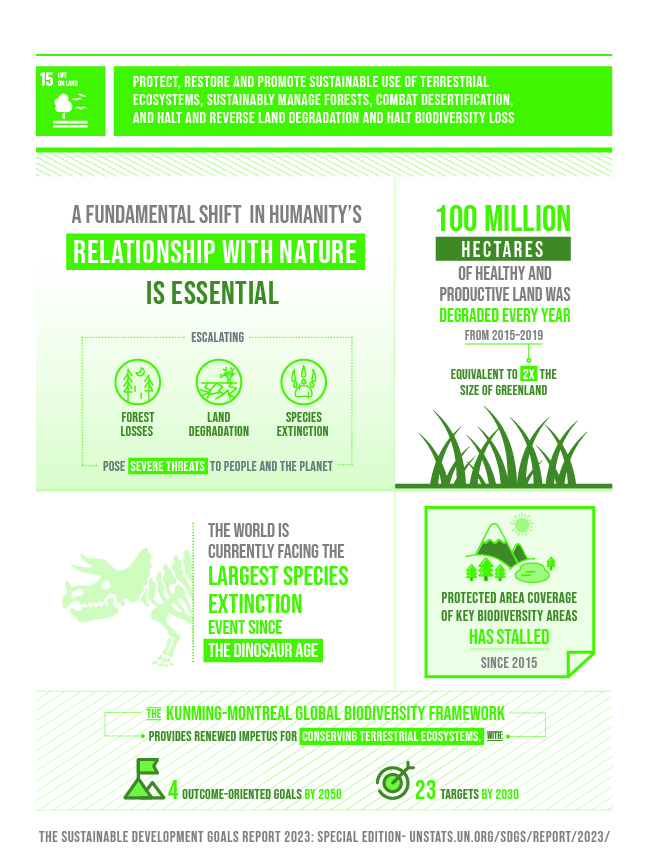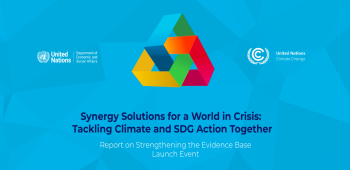
Biodiversity and ecosystems

Desertification, land degradation and drought
Overview
Targets and Indicators

15.1
By 2020, ensure the conservation, restoration and sustainable use of terrestrial and inland freshwater ecosystems and their services, in particular forests, wetlands, mountains and drylands, in line with obligations under international agreements
15.1.1
15.1.2

15.2
By 2020, promote the implementation of sustainable management of all types of forests, halt deforestation, restore degraded forests and substantially increase afforestation and reforestation globally
15.2.1

15.3
By 2030, combat desertification, restore degraded land and soil, including land affected by desertification, drought and floods, and strive to achieve a land degradation-neutral world
15.3.1

15.4
By 2030, ensure the conservation of mountain ecosystems, including their biodiversity, in order to enhance their capacity to provide benefits that are essential for sustainable development
15.4.1
15.4.2

15.5
Take urgent and significant action to reduce the degradation of natural habitats, halt the loss of biodiversity and, by 2020, protect and prevent the extinction of threatened species
15.5.1

15.6
Promote fair and equitable sharing of the benefits arising from the utilization of genetic resources and promote appropriate access to such resources, as internationally agreed
15.6.1

15.7
Take urgent action to end poaching and trafficking of protected species of flora and fauna and address both demand and supply of illegal wildlife products
15.7.1

15.8
By 2020, introduce measures to prevent the introduction and significantly reduce the impact of invasive alien species on land and water ecosystems and control or eradicate the priority species
15.8.1

15.9
By 2020, integrate ecosystem and biodiversity values into national and local planning, development processes, poverty reduction strategies and accounts
15.9.1
(a) Number of countries that have established national targets in accordance with or similar to Aichi Biodiversity Target 2 of the Strategic Plan for Biodiversity 2011–2020 in their national biodiversity strategy and action plans and the progress reported towards these targets; and (b) integration of biodiversity into national accounting and reporting systems, defined as implementation of the System of Environmental-Economic Accounting

15.a
Mobilize and significantly increase financial resources from all sources to conserve and sustainably use biodiversity and ecosystems
15.a.1
(a) Official development assistance on conservation and sustainable use of biodiversity; and (b) revenue generated and finance mobilized from biodiversity-relevant economic instruments

15.b
Mobilize significant resources from all sources and at all levels to finance sustainable forest management and provide adequate incentives to developing countries to advance such management, including for conservation and reforestation
15.b.1
(a) Official development assistance on conservation and sustainable use of biodiversity; and (b) revenue generated and finance mobilized from biodiversity-relevant economic instruments

15.c
Enhance global support for efforts to combat poaching and trafficking of protected species, including by increasing the capacity of local communities to pursue sustainable livelihood opportunities
15.c.1
Progress and Info
SDG 15 underscores the critical importance of biodiversity as humanity’s life-support system. Yet, the relentless depletion of forests, coupled with an alarming rate of species extinction and stagnation in safeguarding key biodiversity areas, jeopardizes the delicate balance of our ecosystems. To address the pressing global environmental challenges and crises, including climate change, biodiversity loss, and pollution, as well as desertification, land and soil degradation, drought and deforestation, it is imperative to intensify efforts in fulfilling our global environmental and biodiversity commitments =.
Targets 15.1 and 15.2: The world’s forest area continues to decline, albeit at a slightly reduced pace compared to previous decades. The proportion of forest cover to total land area decreased from 31.9% in 2000 to 31.2% in 2020 with agricultural expansion accounting for nearly 90% of global deforestation. However, there has been notable progress towards sustainable forest management, marked by an increase in the proportion of forests under management plans and within protected areas. Moreover, certified forest area, which had shown steady long-term growth, has experienced a significant decline in the last two years, attributed to suspension of certificates due to the conflict in Europe.
Targets 14.5, 15.1 and 15.4: Global protected and conserved area coverage of marine, terrestrial, freshwater and mountain key biodiversity areas showed substantial improvements prior to 2000, this growth has stagnated over the last two decades. Particularly worrying is Central, Southern and Western Asia, Northern Africa, and Oceania, where average protected and conserved area coverage of key biodiversity areas is less than 30%. Progress has been more positive in Northern America and Europe, Sub-Saharan Africa, Latin America and the Caribbean, and Australia and New Zealand, where over 40% of each key biodiversity area is now covered on average.
Target 15.5: Species extinction risk continues to worsen, as evidenced by a 12% deterioration in the aggregate Red List Index between 2024 and 1993 (and 4% since 2015). The extinction risk of the world’s amphibian species was recently comprehensively re-assessed, revealing that for amphibians, climate change impacts, habitat conversion and alien invasive fungal disease are the most severe drivers of increasing extinction risk.
Target 15.6: Countries continue to make progress in ratifying and implementing access and benefit-sharing instruments. By the end of 2023, 75 countries (up from 6 countries in 2016) and 93 countries (up from 12 countries in 2015) had reported on their legislative, administrative or policy measures under the Nagoya Protocol and the International Treaty on Plant Genetic Resources for Food and Agriculture, respectively.
Target 15.7.1/15.c.1: Estimates available for the first time show that, globally, intercepted illegal wildlife trade as a proportion of all wildlife trade (legal and illegal) increased from 2017 onwards, reaching its highest levels during the COVID-19 pandemic in 2020-2021. It is estimated that wildlife seizures made up around 1.4 to 1.9% of global wildlife trade in 2020-2021.
Target 15.9: In 2023, 90 countries implemented the international statistical standard to measure the environment and ecosystems and their connection to the economy, an increase of 30% since 2017.








